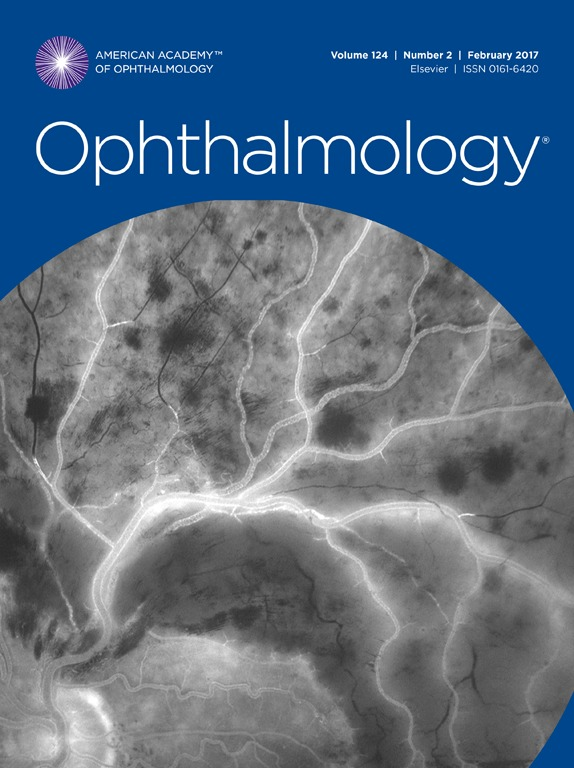The Clinical Usefulness of a Glaucoma Polygenic Risk Score in 4 Population-Based European Ancestry Cohorts
IF 13.1
1区 医学
Q1 OPHTHALMOLOGY
引用次数: 0
Abstract
Purpose
We used a polygenic risk score (PRS) to identify high-risk groups for primary open-angle glaucoma (POAG) within population-based cohorts.
Design
Secondary analysis of 4 prospective population-based studies.
Participants
We included four European-ancestry cohorts: the United States-based Nurses’ Health Study, Nurses’ Health Study 2, and the Health Professionals Follow-up Study and the Rotterdam Study (RS) in The Netherlands. The United States cohorts included female nurses and male health professionals ≤ 55 years of age. The RS included residents ≤ 45 years of age living in Rotterdam, The Netherlands.
Methods
Polygenic risk score weights were estimated by applying the lassosum method on imputed genotype and phenotype data from the UK Biobank. This resulted in 144 020 variants, single nucleotide polymorphism and insertions or deletions, with nonzero βs that we used to calculate a PRS in the target populations. Using multivariable Cox proportional hazard models, we estimated the relationship between the standardized PRS and relative risk for POAG. Additionally, POAG prediction was tested by calculating these models’ concordance (Harrell’s C statistic). Finally, we assessed the association between PRS tertiles and glaucoma-related traits.
Main Outcome Measures
The relative risk for POAG and Harrell’s C statistic.
Results
Among 1046 patients and 38 809 control participants, the relative risk (95% confidence interval) for POAG for participants in the highest PRS quintile was 3.99 (3.08–5.18) times higher in the United States cohorts and 4.89 (2.93–8.17) times higher in the RS, compared with participants with median genetic risk (third quintile). Combining age, sex, intraocular pressure of more than 25 mmHg, and family history resulted in a meta-analyzed concordance of 0.75 (95% CI, 0.73–0.75). Adding the PRS to this model improved the concordance to 0.82 (95% CI, 0.80–0.84). In a meta-analysis of all cohorts, patients in the highest tertile showed a larger cup-to-disc ratio at diagnosis, by 0.10 (95% CI, 0.06–0.14), and a 2.07-fold increased risk of requiring glaucoma surgery (95% CI, 1.19–3.60).
Conclusions
Incorporating a PRS into a POAG predictive model improves identification concordance from 0.75 up to 0.82, supporting its potential for guiding more cost-effective screening strategies.
Financial Disclosure(s)
Proprietary or commercial disclosure may be found in the Footnotes and Disclosures at the end of this article.
青光眼多基因风险评分在四个欧洲裔人群队列中的临床实用性。
目的:我们使用多基因风险评分(PRS)在人群队列中识别原发性开角型青光眼(POAG)的高风险群体:我们使用多基因风险评分(PRS)在基于人群的队列中识别原发性开角型青光眼(POAG)的高风险人群:设计:对四项前瞻性人群研究进行二次分析:我们纳入了四项欧洲人群队列研究:基于美国的护士健康研究(NHS)、NHS2、卫生专业人员随访研究以及荷兰的鹿特丹研究(RS)。美国队列包括 55 岁以上的女护士和男性保健专业人员。RS 包括居住在荷兰鹿特丹的 45 岁或以上的居民:PRS权重是通过对来自英国生物库(UK-Biobank)的估算基因型和表型数据应用Lassosum方法进行估算的。这样就得到了 144,020 个变体,包括单核苷酸多态性(SNP)和嵌合体,我们用这些变体计算目标人群的 PRS,其 Betas 均不为零。我们使用多变量 Cox 比例危险模型估算了标准化 PRS 与 POAG 相对风险之间的关系。此外,我们还通过计算这些模型的一致性(Harrell's C 统计量)对 POAG 预测进行了检验。最后,我们评估了 PRS tertiles 与青光眼相关特征之间的关联:POAG 的相对风险和 Harrell 的 C 统计量(相当于纵向模型的曲线下面积):在 1,046 例病例和 38,809 例对照中,与遗传风险中位数(第 3 个五分位数)的参与者相比,PRS 最高五分位数参与者的 POAG 相对风险(95% 置信区间)在美国队列中为 3.99(3.08,5.18),在鹿特丹研究中为 4.89(2.93,8.17)。在限制性立方样条分析中,连续 PRS 与 POAG 风险之间的关系在美国和鹿特丹队列中呈指数增长(Pspline25 mmHg),家族史导致荟萃分析的一致性为 0.75(0.73,0.75)。将 PRS 加入该模型后,一致性提高到 0.82(0.80,0.84)。在对所有队列进行的荟萃分析中,最高三分位数的病例在确诊时杯盘比值较大,增加了 0.11 (0.07, 0.15),需要进行青光眼手术的风险增加了 2.07 倍 (1.19, 3.60):将 PRS 纳入 POAG 预测模型可将识别一致性从 0.75 提高到 0.82,从而支持其在指导更具成本效益的筛查策略方面的潜力。
本文章由计算机程序翻译,如有差异,请以英文原文为准。
求助全文
约1分钟内获得全文
求助全文
来源期刊

Ophthalmology
医学-眼科学
CiteScore
22.30
自引率
3.60%
发文量
412
审稿时长
18 days
期刊介绍:
The journal Ophthalmology, from the American Academy of Ophthalmology, contributes to society by publishing research in clinical and basic science related to vision.It upholds excellence through unbiased peer-review, fostering innovation, promoting discovery, and encouraging lifelong learning.
 求助内容:
求助内容: 应助结果提醒方式:
应助结果提醒方式:


